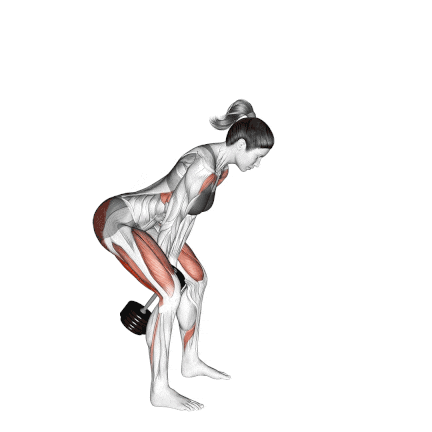The dumbbell swing is a full-body exercise that combines strength training and cardio fitness. It is a variation of the traditional kettlebell swing.
Since dumbbells are more commonly available in gyms and homes, it is more accessible exercise than their kettlebell counterparts.
It takes a strong hip hinge to lift a dumbbell from between the legs to shoulder height. This explosive movement engages the muscles of the lower body, core, and shoulder.
Think of it like throwing a baseball. The power doesn’t come from your arm but from your legs and core, which transfer energy through your body to your hand. That’s exactly what happens in a dumbbell swing.

Dumbbell Swing Muscles Worked
- Primary Muscles: Posterior Chain (glutes, hamstrings, and lower back)
- Secondary Muscles: Quads, Latissimus Dorsi, Deltoid, Trapezius and Core Muscles (Abs and Obliques)
- Stabilizing Muscles: Rotator Cuff Muscles, Rhomboids, Serratus Anterior, Deep Spinal Stabilizers and Forearm Muscles.
How To Do Dumbbell Swing
- Stand with your feet slightly wider than shoulder-width apart, toes pointed slightly outward. Hold a dumbbell with both hands, gripping the handle firmly.
- Your arms should be straight, and the dumbbell should hang between your legs.
- Keep your chest up, shoulders back, and core engaged. Your knees should be slightly bent.
- Push your hips back, bending at the hips rather than the knees. Your torso should lean forward.
- Keep your back flat and avoid rounding your lower back. Your head should follow the natural line of your spine, with your gaze slightly ahead.
- Engage your core and glutes. Explosively, drive your hips forward, standing up tall. The momentum will carry the dumbbell up to about shoulder height or eye level.
- Allow the dumbbell to swing back down between your legs as you hinge at your hips again. Stay in control and don’t let the weight push you forward.
- Continue the swinging motion smoothly and controlly, maintaining a steady rhythm.
Tips and Form
- Focus on pushing your hips back, not squatting down.
- Focus on maintaining a neutral spine. Engage your core and shoulder retracted to avoid rounding.
- The power should come from your glutes and hamstrings, not your lower back.
- Maintain a “proud chest” to help keep your spine neutral.
- It’s a swing, not a front raise. Resist the urge to try to get the weight as high as possible.
- All movement should come from the hip hinge, and your arms should only be used to hold onto the weight.
- Keep your neck in a neutral position, aligned with your spine. Avoid looking up at the top of the swing or tucking your chin excessively.
- The dumbbell should reach approximately chest height. Swinging too high can put unnecessary stress on your shoulders.

References
- Duncan, Michael J., Rosanna Gibbard, Leanne M. Raymond, and Peter Mundy. 2015. “The Effect of Kettlebell Swing Load and Cadence on Physiological, Perceptual and Mechanical Variables” Sports 3, no. 3: 202-208. https://doi.org/10.3390/sports3030202

Manish is a NASM-certified fitness and nutrition coach with over 10 years of experience in weight lifting and fat loss fitness coaching. He specializes in gym-based training and has a lot of knowledge about exercise, lifting technique, biomechanics, and more.
Through “Fit Life Regime,” he generously shares the insights he’s gained over a decade in the field. His goal is to equip others with the knowledge to start their own fitness journey.
